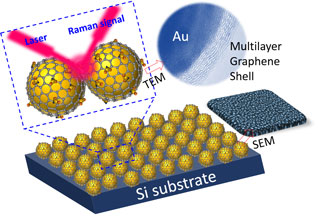Article contents
Self-patterning of graphene-encapsulated gold nanoparticles for surface-enhanced Raman spectroscopy
Published online by Cambridge University Press: 29 January 2018
Abstract

The main challenges of developing advanced surface-enhanced Raman spectroscopy (SERS) sensors lie in the poor reproducibility, low uniformity, and the lack of molecular selectivity. In this paper, we report a facile and cost-effective approach for the large-scale patterning of graphene-encapsulated Au nanoparticles on Si substrate as efficient SERS sensors with highly-improved uniformity, reproducibility, and unique selectivity. The materials production was accomplished via an industry-applicable galvanic deposition—annealing—chemical vapor deposition approach, followed by a final plasma treatment. Our study provides a facile approach to the fabrication of uniform SERS substrate and further prompts the practical progress of SERS-based chemical sensors.
- Type
- Research Letters
- Information
- Copyright
- Copyright © Materials Research Society 2018
References
- 8
- Cited by




